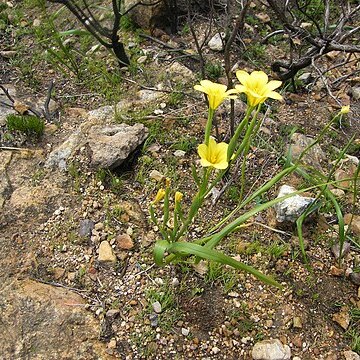Herb 40–70 cm high. Corm c. 2 cm diam. Leaf solitary, inserted above ground level, longer than scape, 6–15 mm wide. Scape branched, never flexuose; bracts 6–7 cm long. Outer spathe 3–4 cm long, inner 6–8 cm long. Flowers yellow, sometimes with orange centre, or completely orange. Sepals and petals obovate, 3–4 cm long, the claws forming an open cup 2–3 cm diam. Filaments connate in tapered tube 7–10 mm long, glabrous; anthers 5–8 mm long, divergent from base. Ovary 1.3-1.6 cm long; style trifid at base of anthers; branches divergent, 5–6 mm long; stigmas held above anthers, bilobed; style crests absent or vestigial and obtuse. Capsules 2–4 cm long; beak obtuse, c. 1 mm long.
Cormous geophyte, 35-75 cm. Leaf solitary, occasionally 2, linear, channelled. Flowers yellow to orange or bicoloured, tepal claws forming a wide cup, filament column slender, anthers partly exserted.

